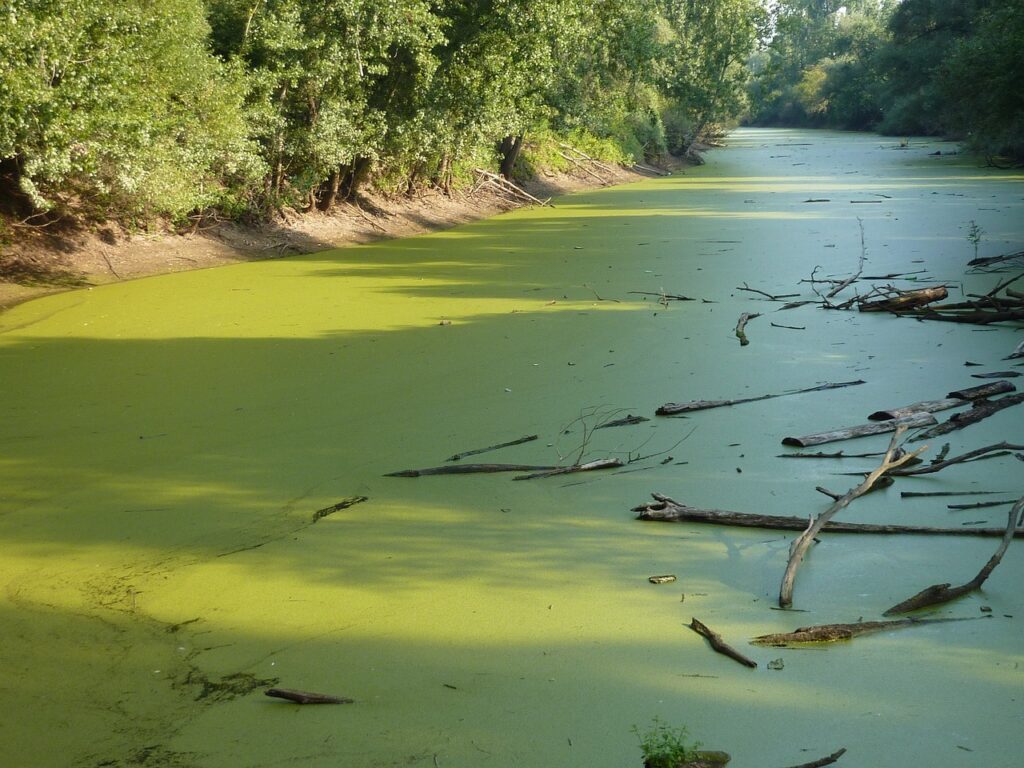
18 Fascinating Facts About Algae: Nature’s Unsung Heroes
Facts About Algae
Firstly throughout this article, fascinating facts about algae will be explored, including their symbiotic relationships with other organisms, their contributions to food chains, and their ability to adapt to various environments.
By understanding algae’s crucial role, we can better appreciate their importance and address environmental challenges such as harmful algal blooms and climate change.
Algae, a fascinating and diverse group of photosynthetic organisms, often go unnoticed despite their critical importance to life on Earth.
Found in aquatic environments ranging from freshwater lakes to deep oceans, these plant-like organisms contribute significantly to oxygen production and play an essential role in aquatic ecosystems.
Thus in recent years, their potential applications in various industries have sparked increasing interest.
What Are Algae?
Algae are a diverse group of photosynthetic organisms found in aquatic environments, brackish waters, and even extreme conditions like hot springs or ice crystals.
Unlike land plants, they lack vascular tissues and true roots. However, algae produce their own food through photosynthesis, harnessing sunlight to create energy-rich compounds essential for their survival.
Algae range from microscopic algae, such as single cells, to larger species like the giant kelp.
Different Types of Algae
- Green Algae (Chlorophyta): These species of green algae are primarily found in freshwater environments and are closely related to land plants.
- Blue-Green Algae (Cyanobacteria): Despite their name, blue-green algae are not true algae but bacteria capable of photosynthesis.
- Brown Algae (Phaeophyceae): Commonly found in marine environments, brown algae include the largest algae, such as giant kelp.
- Red Algae (Rhodophyta): Red algae thrive in deep waters and play a significant role in building coral reefs.

Read Next: Genuine Plus Awesome Fun Facts About Starfish (The Best 20)
Algae’s Important Roles in Aquatic Ecosystems
Oxygen Production
Remarkably, algae contribute to producing over 50% of the Earth’s oxygen through the process of photosynthesis.
These primary producers are at the base of the food chain, supporting aquatic organisms and indirectly benefiting terrestrial life.
Improving Water Quality
Beneficial algae species enhance water quality by absorbing harmful chemicals and excess nutrients from water bodies. For example, in wastewater treatment plants, algae play a vital role in removing contaminants.
Supporting Aquatic Life
Algae form the food base for countless aquatic animals, including small fish and zooplankton. In coral reefs, algae maintain a symbiotic relationship with corals, providing them with essential nutrients.
Interesting Facts About Algae
- Algae were among the first organisms to perform photosynthesis, contributing to the formation of the Earth’s atmosphere.
- The world’s oxygen owes much to the efforts of algae, which account for a substantial part of oxygen levels in the Earth’s atmosphere.
- In addition to supporting aquatic animals, algae are also an important source of food for humans, offering essential nutrients and even serving as nutritional supplements.
Algae and Climate Change
In the fight against climate change, algae are considered a promising tool for carbon capture. In fact their ability to absorb carbon dioxide emissions and produce biofuels highlights their potential applications in mitigating environmental damage.
Source: NOAA on Harmful Algal Blooms
The Beneficial Roles of Algae in Various Industries

Algae in the Human Diet
Algae have long been an important source of food, particularly in coastal cultures. Rich in essential nutrients and chlorophyll pigments, algae are a staple food in many Asian countries.
For example, red algae like nori are used in sushi, while brown algae such as wakame are common in soups.
These plant-like organisms are also a source of essential fatty acids and nutritional supplements, promoting a balanced diet.
Potential Health Benefits
- Algae contain antioxidants that combat free radicals, improving overall health.
- Certain algae species have been linked to the treatment of stomach disorders and urinary infections.
- In fact algae are also known for their potential in reducing inflammation and boosting immunity.
Algae in Energy Production
Algae have gained attention in recent years for their role in the production of biofuels. Thus their rapid growth and ability to thrive in diverse environments make them a sustainable alternative to fossil fuels.
Power plants and other industries are increasingly looking toward algae for renewable energy solutions.
Types of Algae and Their Unique Traits

Microscopic Algae
Microscopic algae, such as phytoplankton, are crucial to aquatic life. Despite their tiny size, these single-celled organisms form the foundation of aquatic food chains, supporting marine life from small fish to large whales.
Giant Kelp: The Largest Algae
The giant kelp, a type of brown algae, stands out as the largest algae species. Growing up to 60 meters long, it forms underwater forests that serve as habitats for various aquatic animals.
These kelp forests also play an important role in stabilizing marine ecosystems and capturing carbon dioxide.
Blue-Green Algae
Blue-green algae, or cyanobacteria, are known for their dual roles. While they contribute to oxygen production, they can also produce harmful chemicals, leading to harmful algal blooms in water bodies.
These blooms impact water quality and pose risks to human health and aquatic organisms.
Algae’s Role in Aquatic Environments

Algae Blooms: A Double-Edged Sword
Algae blooms can both benefit and harm aquatic ecosystems. While blooms of beneficial algae species enhance the food base for aquatic organisms, harmful algal blooms release toxins that endanger marine life and human health.
Hence, managing these blooms is crucial for maintaining the balance of aquatic ecosystems.
Symbiotic Relationships
Algae often form symbiotic relationships with other organisms. For example, red algae provide coral reefs with oxygen and essential nutrients, allowing corals to thrive.
This relationship is vital for the survival of diverse marine species that depend on reefs for shelter and food.
Related article: Fun Facts About Seahorses: Unlock The Best 32
Fun Facts About Algae
- Algae can grow in unusual environments, including hot springs and ice crystals.
- The study of algae, known as phycology, helps scientists understand their vital role in ecosystems.
- Pond scum, often considered unsightly, is made up of valuable algae that contribute to oxygen levels and nutrient cycling in freshwater environments.
Algae and Their Impact on the Environment

Algae’s Vital Role in the Earth’s Atmosphere
One of the most compelling facts about algae is their contribution to the Earth’s oxygen.
Through the process of photosynthesis, algae absorb carbon dioxide and release oxygen, producing a significant portion of the world’s oxygen.
This process is essential for maintaining the Earth’s atmosphere and supporting life on the planet.
Algae and Climate Change Mitigation
Algae are increasingly recognized for their potential in addressing climate change. By capturing carbon dioxide emissions, algae reduce greenhouse gases in the atmosphere.
Furthermore, certain types of algae have been explored for carbon capture technologies, which aim to lower carbon levels and mitigate the effects of global warming.
Algae in Wastewater Treatment
In wastewater treatment plants, algae play an important role in purifying water. These photosynthetic organisms absorb harmful chemicals and excess nutrients, improving water quality.
This process not only supports aquatic life but also ensures cleaner water for human use.
Potential Applications of Algae in Various Industries

Algae in Agriculture
Algae have become an important food source for livestock feed. Packed with essential nutrients, algae-based feed enhances animal health and improves agricultural productivity.
Additionally, algae are used as fertilizers, enriching soil and promoting sustainable farming practices.
Algae in Medicine
Algae’s bioactive compounds have potential applications in medicine. These compounds are being studied for their ability to combat diseases, including stomach disorders and urinary infections.
Furthermore, algae-derived products are used in the creation of pharmaceuticals and therapeutic treatments.
Algae in Technology
In technological advancements, algae serve as a key ingredient in the production of biodegradable plastics and biofuels.
These innovations reduce reliance on fossil fuels and harsh chemicals, promoting sustainability across various industries.
Frequently Asked Questions: Facts About Algae

What is the study of algae called?
The study of algae is known as phycology, a branch of science dedicated to understanding these diverse organisms and their roles in ecosystems.
How do algae differ from land plants?
Unlike land plants, algae lack vascular tissues, true roots, stems, and leaves. However, they perform photosynthesis using chlorophyll pigments, much like plants.
Are all algae beneficial?
Not all algae are beneficial. While many types support aquatic life and oxygen production, some species cause harmful algal blooms, releasing toxins that harm ecosystems and human health.
What are the different types of algae?
Algae are broadly categorized into groups, including green algae, blue-green algae, brown algae, and red algae. Each type has unique characteristics and habitats.
How do algae contribute to the environment?
Algae play a vital role in producing oxygen, supporting food chains, and improving water quality. They also help capture carbon dioxide, addressing climate change.
Related Article: Interesting Facts About Marine Biologists
Facts About Algae Conclusion
Finally, algae are more than just plant-like organisms floating in water bodies.
Moreover these diverse organisms are a cornerstone of life on Earth, contributing to oxygen production, supporting aquatic ecosystems, and offering potential solutions to environmental challenges.
From their role in food chains to their applications in industries like medicine and technology, algae demonstrate their immense value to humanity and the planet.
By understanding and respecting the important role of algae, we can harness their benefits while mitigating the challenges posed by harmful algal blooms and climate change.
Indeed, the more we learn about these remarkable organisms, the more we appreciate their ability to sustain life and shape the future.
Please share these facts about algae with your friends and help spread the word about these exceptional organisms, thank you.




